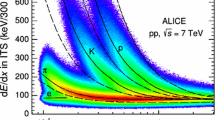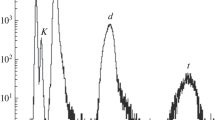Abstract
A measurement of the double-differential cross-section for the production of charged pions in proton–tantalum collisions emitted at large angles from the incoming beam direction is presented. The data were taken in 2002 with the HARP detector in the T9 beam line of the CERN PS. The pions were produced by proton beams in a momentum range from 3 GeV/c to 12 GeV/c hitting a tantalum target with a thickness of 5% of a nuclear interaction length. The angular and momentum range covered by the experiment (100 MeV/c ≤p< 800 MeV/c and 0.35 rad ≤θ< 2.15 rad) is of particular importance for the design of a neutrino factory. The produced particles were detected using a small-radius cylindrical time projection chamber (TPC) placed in a solenoidal magnet. Track recognition, momentum determination and particle identification were all performed based on the measurements made with the TPC. An elaborate system of detectors in the beam line ensured the identification of the incident particles. Results are shown for the double-differential cross-sections d2σ/dpdθ at four incident proton beam momenta (3 GeV/c, 5 GeV/c, 8 GeV/c and 12 GeV/c). In addition, the pion yields within the acceptance of typical neutrino factory designs are shown as a function of beam momentum. The measurement of these yields within a single experiment eliminates most systematic errors in the comparison between rates at different beam momenta and between positive and negative pion production.
Similar content being viewed by others
References
HARP Collaboration, M.G. Catanesi et al., Proposal to study hadron production for the neutrino factory and for the atmospheric neutrino flux, CERN-SPSC/99-35 (1999)
G. Battistoni, Nucl. Phys. B Proc. Suppl. 100, 101 (2001)
T. Stanev, Rapporteur’s talk at the 26th Int. Cosmic Ray Conference (Salt Lake City, Utah, USA), ed. by B.L. Dingus et al., AIP Conf. Proceedings 516, (2000) 247
T.K. Gaisser, Nucl. Phys. B Proc. Suppl. 87, 145 (2000)
R. Engel, T.K. Gaisser, T. Stanev, Phys. Lett. B 472, 113 (2000)
M. Honda, Nucl. Phys. B 77, 140 (1999)
K2K Collaboration, M.H. Ahn et al., Phys. Rev. Lett. 90, 041801 (2003)
M.H. Ahn et al., K2K Collaboration, Phys. Rev. D 74, 072003 (2006) [arXiv:hep-ex/0606032]
BooNe Collaboration, E. Church et al., A proposal for an experiment to measure muon-neutrino → electron-neutrino oscillations and muon-neutrino disappearance at the Fermilab Booster: BooNE, FERMILAB-PROPOSAL-0898, (1997))
BooNE Collaboration, A.A. Aguilar-Arevalo et al., arXiv:0704.1500 (2007)
SciBooNE Collaboration, A.A. Aguilar-Arevalo et al., Bringing the SciBar detector to the Booster neutrino beam, FERMILAB-PROPOSAL-0954, (2006), arXiv:hep-ex/0601022
M. Apollonio et al., Oscillation Physics with a Neutrino Factory, CERN TH2002-208, arXiv:hep-ph/0210192
BENE Steering Group, A. Baldini et al., CERN-2006-005
A. Blondel et al., CERN-2004-002, ECFA/04/230
HARP Collaboration, M.G. Catanesi et al., Nucl. Instrum. Methods A 571, 527 (2007)
HARP Collaboration, M.G. Catanesi et al., Nucl. Instrum. Methods A 571, 564 (2007)
HARP Collaboration, M.G. Catanesi et al., Nucl. Phys. B 732, 1 (2006) [arXiv:hep-ex/0510039]
HARP Collaboration, M.G. Catanesi et al., Nucl. Instrum. Methods A 572, 899 (2007)
HARP Collaboration, M.G. Catanesi et al., Measurement of the production cross-section of positive pions in the collision of 8.9 GeV/c protons on beryllium, arXiv:hep-ex/0702024
M. Anfreville et al., Nucl. Instrum. Methods A 481, 339 (2002)
NOMAD Collaboration, J. Altegoer et al., Nucl. Instrum. Methods A 404, 96 (1998)
M. Baldo-Ceolin et al., Nucl. Instrum. Methods A 532, 548 (2004)
S. Buontempo et al., Nucl. Instrum. Methods A 349, 70 (1994)
E. Di Capua et al., Nucl. Instrum. Methods A 378, 221 (1996)
E. Radicioni, IEEE Trans. Nucl. Sci. 52, 2986 (2005), presented at NSS2004
M. Bogomilov et al., Nucl. Instrum. Methods A 508, 152 (2003)
G. Barr et al., Nucl. Instrum. Methods A 533, 214 (2004)
L. Durieu, A. Mueller, M. Martini, PAC-2001-TPAH142, Presented at IEEE Particle Accelerator Conference (PAC2001), Chicago, Illinois, 18–22 Jun 2001
L. Durieu et al., Proceedings of PAC’97, Vancouver (1997)
L. Durieu, O. Fernando, CERN PS/PA Note 96–38
K. Pretzl et al., Invited talk at the International Symposium on Strangeness and Quark Matter, Crete, 230 (1999)
J.W.E. Uiterwijk, J. Panman, B. Van de Vyver, Nucl. Instrum. Methods A 560, 317 (2006)
J. Knobloch et al., Status of the Reconstruction Algorithms for ALEPH, ALEPH-Note 88–46
M.C. Morone, Evaluation of Silicon sensors for the ATLAS Silicon Tracker, and TPC Reconstruction in the HARP Experiment, Ph.D. Thesis, University of Geneva, 2003
N.I. Chernov, G.A. Ososkov, Comput. Phys. Commun. 33, 329 (1984)
M. Bogomilov et al., IEEE Trans. Nucl. Sci. 54, 342 (2007)
GEANT4 Collaboration, S. Agostinelli et al., Nucl. Instrum. Methods A 506, 250 (2003)
G. D’Agostini, Nucl. Instrum. Methods A 362, 487 (1995)
A. Grossheim, Particle production yields induced by multi-GeV protons on nuclear targets, Ph.D. thesis, University of Dortmund, Germany, 2003, CERN-THESIS-2004-010
E910 Collaboration, I. Chemakin et al., Phys. Rev. C 65, 024904 (2002)
D. Armutliiski et al., Hadron spectra in hadron–nucleus collisions (in Russian), JINR-P1-91-191, 1991
K. Long, Nucl. Phys. B Proc. Suppl. 154, 111 (2006)
ISS/2005/01, An international scoping study of a Neutrino Factory and super-beam facility, http://www.hep.ph.ic.ac.uk/iss/issnotes/ISS_Doc1_v02_13-7-2005.pdf
R.C. Fernow, J. Gallardo, private communication
S.J. Brooks, private communication
S.J. Brooks, K. A Walaron, Nucl. Phys. B Proc. Suppl. 155, 295 (2006)
S. Borghi, Hadron production cross section measurement with the HARP large angle detectors, Ph.D. Thesis, N.3781, University of Geneva, Switzerland, 2006, CERN-THESIS-2007-034
Author information
Authors and Affiliations
Consortia
Corresponding author
Additional information
PACS
13.75.Cs; 13.85.Ni
Rights and permissions
About this article
Cite this article
Catanesi, M., Radicioni, E., Edgecock, R. et al. Measurement of the production of charged pions by protons on a tantalum target. Eur. Phys. J. C 51, 787–824 (2007). https://doi.org/10.1140/epjc/s10052-007-0361-0
Received:
Revised:
Published:
Issue Date:
DOI: https://doi.org/10.1140/epjc/s10052-007-0361-0




